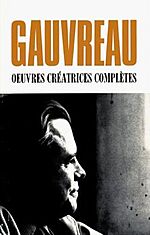Claude Gauvreau facts for kids
Quick facts for kids
Claude Gauvreau
|
|
|---|---|
 |
|
| Born | 19 August 1925 |
| Died | July 7, 1971 (aged 45) |
| Known for | Literature (Poetry, Drama, Prose, Essays), Painting |
| Movement | Automatist |
Claude Gauvreau (born August 19, 1925 – died July 7, 1971) was a Canadian writer from Montreal, Quebec. He wrote plays, poems, and essays. He was also known for his unique "sound poetry." Claude Gauvreau was an important member of a group called the Automatists, and he helped create a famous document known as the Refus Global Manifesto.
Contents
Who Was Claude Gauvreau?
Claude Gauvreau was born in Montreal. He went to college and studied Philosophy at the Université de Montréal. He was very interested in art and writing.
How Did He Get Into Art?
Claude learned about modern art from his brother, Pierre. Pierre was an art student. Through his brother, Claude met a painter named Paul-Émile Borduas. Borduas was the leader of a group of artists called the Automatists. This group believed in creating art freely, using their imagination and subconscious thoughts.
Claude became a strong supporter of the Automatist Movement. In 1948, he helped write the Refus Global ("Total Refusal") Manifesto. This was a very important statement about art and culture in Quebec and Canada. It called for new ways of thinking and creating.
What Did He Write?
Between 1944 and 1947, Claude Gauvreau wrote a collection of 26 short plays called Les Entrailles. In 1947, one of these plays, Bien-être, was performed. An actress named Muriel Guilbault, who was a big inspiration for him, starred in it.
After Muriel Guilbault passed away in 1952, Claude Gauvreau went through a difficult time. He continued to write a lot. From 1952 to 1969, while working for the radio, he wrote many of his well-known works. These included a novel called Beauté baroque (1952), which was about Muriel's life. He also wrote several poetry collections, like Sur fil métamorphose (1956) and Étal Mixte (1968).
In 1958, two more of his short plays, La jeune fille et la lune and Les grappes lucides, were performed.
The Charge of the Expormidable Moose
In 1956, Claude Gauvreau wrote his most famous play, La charge de l'orignal épormyable. This title means The Charge of the Expormidable Moose.
The play is about a poet named Mycroft Mixeudeim. He lives in a shared home and is treated badly by the other people there. They copy his work, make fun of him, and eventually turn against him.
The play was first performed in 1970 in Montreal. It didn't do very well at first because of poor planning. However, after Gauvreau's death, it became very successful. In 1974, it was performed at the Théâtre du Nouveau Monde and was a big hit. It has been performed many times since then and was even made into a TV show in 1992.
Later Life and Legacy
On March 27, 1970, Claude Gauvreau took part in La Nuit de la poésie (The Night of Poetry). This was the biggest poetry festival ever held in Quebec.
Claude Gauvreau passed away on July 7, 1971, after falling from the roof of his building. The authorities said it was an accident.
His last full-length play, Les oranges sont vertes, was performed after he passed away, in 1972. Six years later, in 1977, a huge collection of all his writings, called Complete Creative Works, was published. It contained over 1,500 pages of his poetry, stories, and plays.
Claude Gauvreau was very creative with language. He even invented his own type of sound poetry which he called explorean language. His unique life and work have inspired many Canadian artists, including performance poets like The Four Horsemen.
Images for kids


